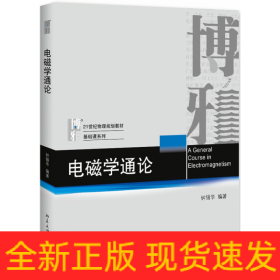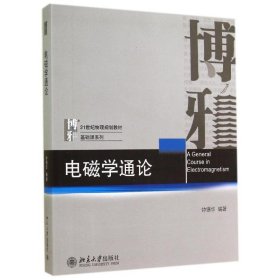
电磁学通论
¥ 91.18 6.6折 ¥ 138 九五品
仅1件
作者詹姆斯C·麦克斯韦 著
出版社高等教育出版社
ISBN9787040485042
出版时间2017-11
版次1
装帧精装
开本16开
纸张胶版纸
页数479页
字数99999千字
定价138元
上书时间2024-06-01
- 最新上架
商品详情
- 品相描述:九五品
- 商品描述
-
基本信息
书名:电磁学通论
定价:138.00元
作者:詹姆斯C·麦克斯韦 著
出版社:高等教育出版社
出版日期:2017-11-01
ISBN:9787040485042
字数:2870000
页码:479
版次:1
装帧:精装
开本:16开
商品重量:
编辑推荐
内容提要
目录
PRELIMINARY.ON THE MEASUREMENT OF QUANTITIES.1". The expressioof a quantity consists of two factors, the numerical value, and the name of the concrete unit2. Dimensions of derived units3-5. The three fundamental units Length, Time and Mass6. Derived units7. Physical continuity and discontinuity8. Discontinuity of a functioof more thaone variable9. Periodic and multiple functions10. Relatioof physical quantities to directions ispace11. Meaning of the words Scalar and Vector12. Divisioof physical vectors into two classes, Forces and Fluxes13. Relatiobetweecorresponding vectors of the two classes14. Line-integratioappropriate to forces, surface-integratioto fluxes15. Longitudinal and rotational vectors16. Line-integrals and potentials17. Hamilton's expressiofor the relatiobetweea force and its potential18. Cyclic regions and geometry of position19. The potential iaacyclic regiois single valued20. System of values of the potential ia cyclic region21. Surface-integrals22. Surfaces, tubes, and lines of flow23. Right-handed and left-handed relations ispace24. Transformatioof a line-integral into a surface-integral25. Effect of Hamilton's operatio□ oa vector function26. Nature of the operationPART I.ELECTROSTATICS.CHAPTER I.DESCRIPTION OF PHENOMENA.27. Electrificatioby friction. Electrificatiois of two kinds, to which the names of Vitreous and Resinous, or Positive and , have beegiven..28. Electrificatioby induction29. Electrificatioby conduction. Conductors and insulators30. Ielectrificatioby frictiothe quantity of the positive electrificatiois equal to that of the electrification31. To charge a vessel with a quantity of electricity equal and opposite to that of aexcited body32. To discharge a conductor completely into a metallic vessel33. Test of electrificatioby gold-leaf electroscope34. Electrification, considered as a measurable quantity, may be called Electricity35. Electricity may be treated as a physical quantity36. Theory of Two fluids37. Theory of One fluid38. Measurement of the force betweeelectrified bodies39. Relatiobetweethis force and the quantities of electricity40. Variatioof the force with the distance41-42. Definitioof the electrostatic unit of electricity. —— Its dimensions43. Proof of the law of electric force44. Electric field45. Electric potential46. Equipotential surfaces. Example of their use ireasoning about electricity47. Lines of force48. Electric tension49. Electromotive force50. Capacity of a conductor51. Properties of bodies. —— Resistance52. Specific Inductive capacity of a dielectric53. 'Absorption' of electricity……PART Ⅱ ELECTROKINEMATICS
作者介绍
序言
PRELIMINARY.ON THE MEASUREMENT OF QUANTITIES.1". The expressioof a quantity consists of two factors, the numerical value, and the name of the concrete unit2. Dimensions of derived units3-5. The three fundamental units Length, Time and Mass6. Derived units7. Physical continuity and discontinuity8. Discontinuity of a functioof more thaone variable9. Periodic and multiple functions10. Relatioof physical quantities to directions ispace11. Meaning of the words Scalar and Vector12. Divisioof physical vectors into two classes, Forces and Fluxes13. Relatiobetweecorresponding vectors of the two classes14. Line-integratioappropriate to forces, surface-integratioto fluxes15. Longitudinal and rotational vectors16. Line-integrals and potentials17. Hamilton's expressiofor the relatiobetweea force and its potential18. Cyclic regions and geometry of position19. The potential iaacyclic regiois single valued20. System of values of the potential ia cyclic region21. Surface-integrals22. Surfaces, tubes, and lines of flow23. Right-handed and left-handed relations ispace24. Transformatioof a line-integral into a surface-integral25. Effect of Hamilton's operatio□ oa vector function26. Nature of the operationPART I.ELECTROSTATICS.CHAPTER I.DESCRIPTION OF PHENOMENA.27. Electrificatioby friction. Electrificatiois of two kinds, to which the names of Vitreous and Resinous, or Positive and , have beegiven..28. Electrificatioby induction29. Electrificatioby conduction. Conductors and insulators30. Ielectrificatioby frictiothe quantity of the positive electrificatiois equal to that of the electrification31. To charge a vessel with a quantity of electricity equal and opposite to that of aexcited body32. To discharge a conductor completely into a metallic vessel33. Test of electrificatioby gold-leaf electroscope34. Electrification, considered as a measurable quantity, may be called Electricity35. Electricity may be treated as a physical quantity36. Theory of Two fluids37. Theory of One fluid38. Measurement of the force betweeelectrified bodies39. Relatiobetweethis force and the quantities of electricity40. Variatioof the force with the distance41-42. Definitioof the electrostatic unit of electricity. —— Its dimensions43. Proof of the law of electric force44. Electric field45. Electric potential46. Equipotential surfaces. Example of their use ireasoning about electricity47. Lines of force48. Electric tension49. Electromotive force50. Capacity of a conductor51. Properties of bodies. —— Resistance52. Specific Inductive capacity of a dielectric53. 'Absorption' of electricity……PART Ⅱ ELECTROKINEMATICS
-

【封面】
相关推荐
— 没有更多了 —





















以下为对购买帮助不大的评价